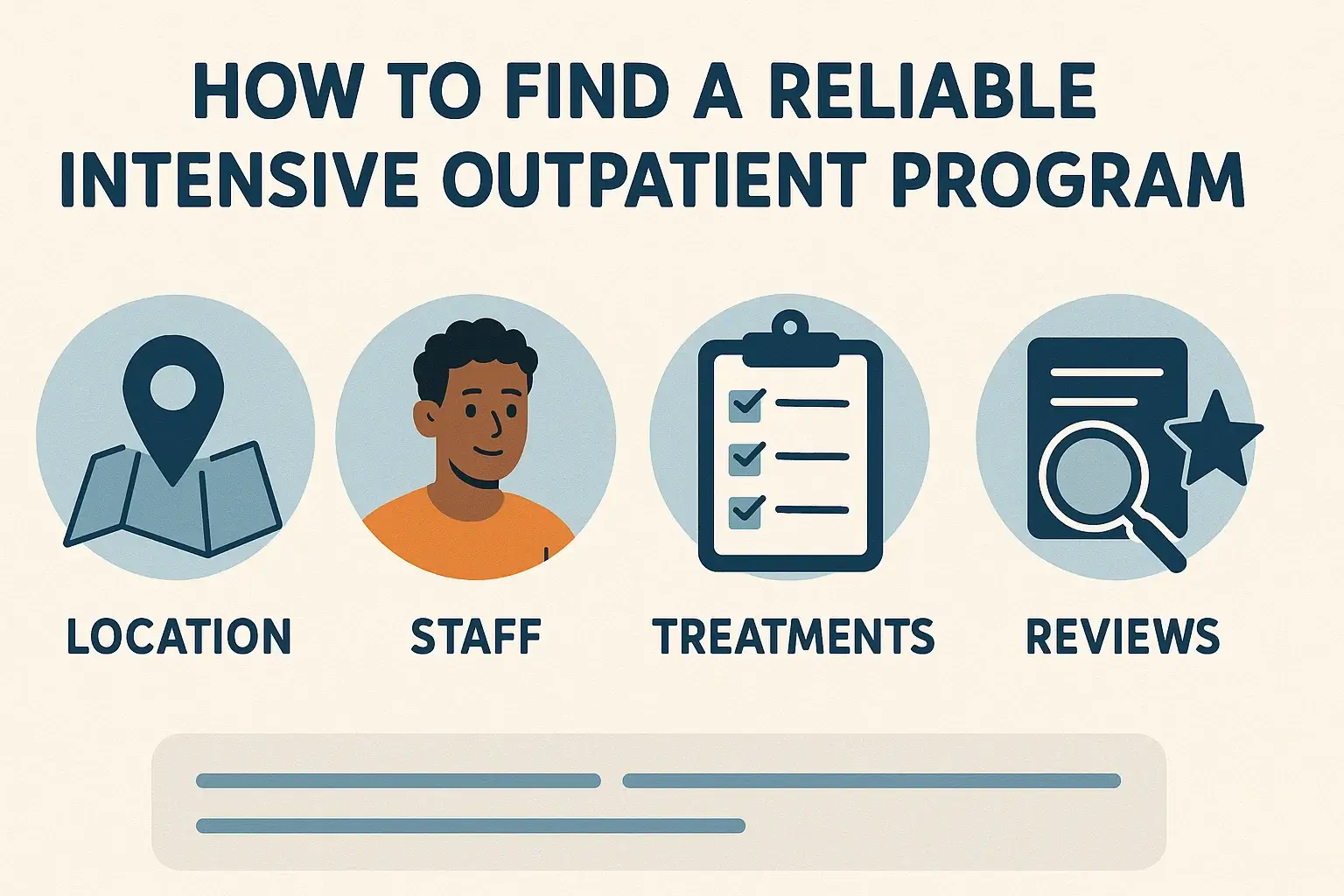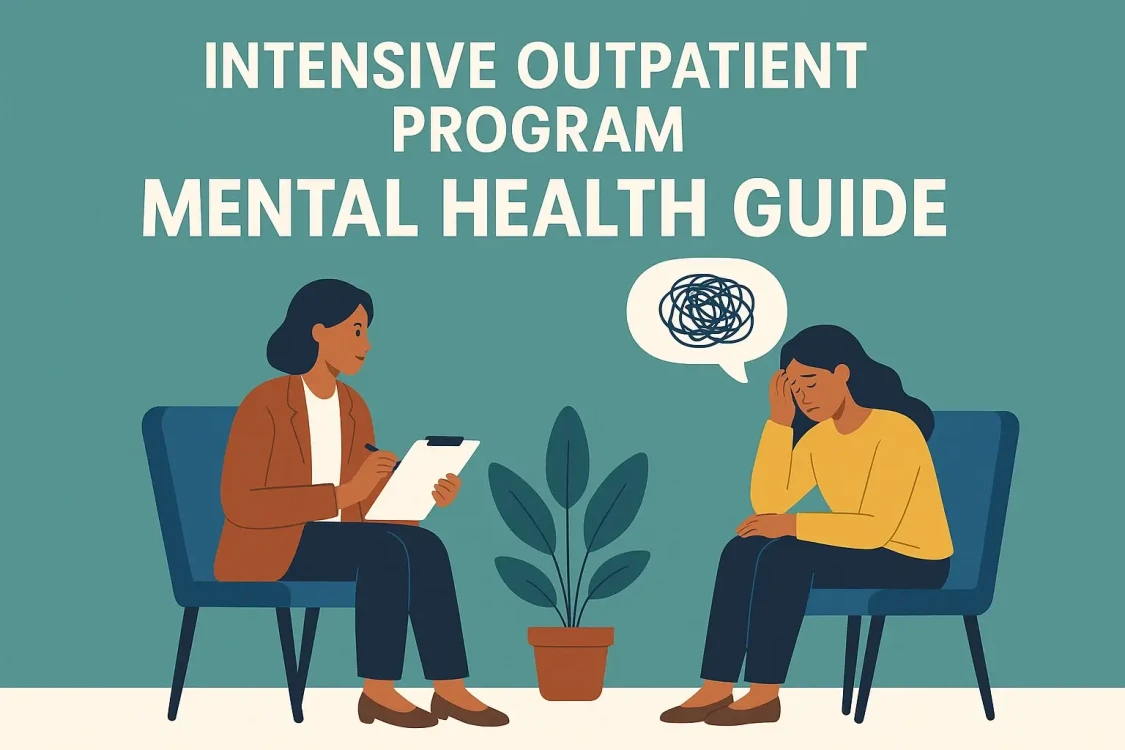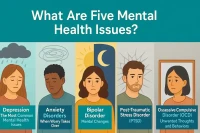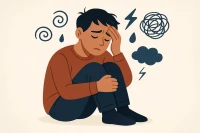Mental health treatment provides varying support. This depends on each person's needs and how severe their symptoms are. Knowing where each option fits helps you or your loved ones find the right care. This care provides necessary support while allowing for independence and normal life participation.
Overview
Mental health treatment varies widely.
You can pick from:
- weekly outpatient therapy
- 24-hour residential care
- different options between
The continuum features standard outpatient therapy for mild to moderate issues.
It also includes:
- Intensive outpatient programs for structured support
- Partial hospitalization for more day treatment
- Inpatient care for crises needing constant supervision
Our Mental Health Issues Guide shows you when to seek different treatment levels for specific conditions.
Where the Intensive Outpatient Program Fits in the Continuum of Care
The intensive outpatient program for mental health fills an important gap. It sits between standard weekly therapy and full-day hospitalization. This option offers structure and support while letting people stay at home. They can keep vital ties to work, school, and family.
Many enjoy intensive outpatient programs when their needs exceed weekly therapy. These programs provide intensive treatment without requiring a break from home life. This balance allows for care while maintaining daily routines.
Purpose and Importance of IOP for Individuals With Mental Health Conditions
Mental health intensive outpatient programs play key roles in treatment. They offer intensive care for those whose symptoms didn't improve with regular outpatient help. They also provide step-down support for individuals transitioning from inpatient or residential care. These programs help keep people from needing to go to the hospital. They also teach coping skills and let participants practice in real-life situations.
The intensive outpatient model understands that many people can join intensive treatment. They can also maintain important life connections that support long-term recovery.
What Is an Intensive Outpatient Program?
Knowing about intensive outpatient programs for mental health can help you choose if this treatment is right for you.
Definition of an Intensive Outpatient Program
An intensive outpatient program (IOP) for mental health is a structured treatment. In this program, individuals go to therapy sessions several times each week. These sessions usually total 9 to 20 hours weekly. Participants can live at home and manage work or school responsibilities.
This definition highlights the balance between intensive care and daily life. IOP is not the same as inpatient treatment, which requires overnight stays. It also differs from partial hospitalization, which involves full days. With IOP, you can schedule around your other commitments.
How It Differs From Inpatient and Partial Hospitalization Programs
Inpatient treatment offers 24-hour care in hospitals or residential settings. It is for people in crisis or those needing constant supervision. This care takes people out of their homes. It ensures safety and offers intensive treatment.
Partial hospitalization programs, or day treatment, need attendees five to seven days a week. Each day lasts about six hours. This option offers more intensive care than outpatient programs. However, individuals can go home each evening.
The intensive outpatient mental health program sits in the middle. It typically requires three to five days a week for three to four hours per session. This schedule offers better treatment and gives you more time for daily activities than partial hospitalization.
Understanding treatment options and resources for psychiatric disorders helps identify the right level of care for specific conditions and symptoms.
Common Goals and Structure of IOP in Mental Health Care
Mental health intensive outpatient programs share common goals despite variations in specific approaches.
Programs focus on:
- Stabilizing acute symptoms.
- Developing effective coping skills.
- Preventing hospitalization or relapse.
- Addressing underlying issues in mental health.
- Preparing individuals for a smooth transition to less-intensive care.
The intensive outpatient mental health program usually includes:
- Individual therapy with assigned therapists.
- Group therapy with peers facing similar issues.
- Skills training in techniques like DBT or CBT.
- Medication management when needed.
- Family sessions to address relationship dynamics affecting mental health.
Who Needs an Intensive Outpatient Program?
Knowing when this level of care is needed helps link people to support before issues grow.
Signs That Someone May Benefit From IOP
What are the signs that someone needs an IOP? Several indicators include. Symptoms might get worse even with weekly therapy. You may notice a decline in work, school, or relationships. Thoughts of self-harm can appear, but there's no immediate plan or intent. Some people may turn to substance use to cope. A recent stay in inpatient or residential treatment might mean you need more support.
The mental health requirements for an intensive outpatient program usually include:
- A willingness to engage actively in treatment.
- The ability to stay safe without 24-hour supervision.
- Consistent attendance at scheduled sessions.
- Symptoms that are severe enough to need intensive care.
Types of Mental Health Issues Typically Treated
 Depression that responds well to intensive outpatient treatment includes:
Depression that responds well to intensive outpatient treatment includes:
- Moderate to severe major depression.
- Treatment-resistant depression that doesn't improve with standard care.
- Depression after inpatient hospitalization.
Resources like Depression vs. Bipolar Disorder clarify key differences. These differences are crucial for effective treatment planning.
Anxiety disorders commonly treated in intensive outpatient programs include:
- Generalized anxiety disorder.
- Panic disorder.
- Social anxiety.
- Specific phobias that significantly impair functioning.
Our Complete Guide to Understanding Anxiety shows what anxiety is and how it responds to different treatments.
Trauma-related conditions, such as post-traumatic stress disorder, benefit from intensive outpatient programs. These programs help with traumatic memories. They also teach coping skills for everyday life.
Other conditions treated include:
- Bipolar disorder during stable phases.
- Obsessive-compulsive disorder.
- Eating disorders need intensive support.
- Co-occurring mental health and substance use disorders.
Suitability for Teens, Adults, and Specific Groups
Adolescent intensive outpatient programs target the specific needs of teens dealing with mental health issues. These programs help teens stay involved in school and maintain peer relationships. Family therapy is often included, as parents play a vital role in recovery.
Adult intensive outpatient mental health programs cater to various groups. This includes young adults, professionals, parents, and seniors. Some programs focus specifically on older adults dealing with age-related mental health issues.
Virtual intensive outpatient programs make mental health services more accessible. They help rural communities, people with transportation problems, and those who like the privacy of home treatment. Online intensive outpatient services have grown significantly and are now well-established treatment options.
How Intensive Outpatient Programs Work
Knowing the typical program structure lets you understand what to expect from this treatment level.
Typical Schedule and Duration of IOP Sessions
Many intensive outpatient mental health programs require you to attend three to five days each week. Each session lasts three to four hours. This adds up to 9 to 20 hours weekly. It's much more intensive than standard outpatient therapy, which is one hour a week. It's easier than partial hospitalization, which needs 30 to 40 hours.
Session times differ by program. Some offer morning, afternoon, or evening slots to fit work or school schedules. Intensive outpatient programs offer great flexibility. This is a big advantage over more intensive options.
Programs usually last four to twelve weeks, based on individual needs and progress. Some people move to less intensive care sooner. Others stay longer to build and practice their skills.
Types of Therapies Used
Cognitive Behavioral Therapy (CBT) is key in many mental health outpatient programs. It helps people identify and change thought patterns that cause emotional distress. CBT also builds practical skills for managing symptoms. This evidence-based method is effective for depression, anxiety, and more.
Dialectical Behavior Therapy (DBT) focuses on four key areas: mindfulness, distress tolerance, emotion regulation, and interpersonal skills. DBT was started for borderline personality disorder. However, it also helps anyone with strong emotions and impulsive actions. Techniques from "How to Calm Anxiety Naturally" fit well with DBT skills.
Group therapy allows people to share their experiences. They can also practice new skills and feel less isolated. It also provides peer support that individual therapy often lacks. The group setting offers unique benefits, like normalizing struggles.
Individual therapy sessions in intensive outpatient programs provide focused attention on specific issues. They help manage tough emotions. They also customize treatment based on each person's goals and situation.
Benefits of Intensive Outpatient Programs
 This treatment level has many benefits. It's appealing for those who need strong support but want to keep their life connections.
This treatment level has many benefits. It's appealing for those who need strong support but want to keep their life connections.
Flexibility and Ability to Maintain Work, School, or Family Life
Intensive outpatient mental health programs let people keep their jobs or attend school. This helps prevent disruptions when returning to daily life after residential treatment.
Working during treatment helps maintain income and health insurance. It also offers structure and purpose, which support mental health. Students can stay in school with accommodations instead of taking medical leave. Parents can continue caring for their children with the right support.
Continued Professional Support While Living at Home
Living at home during treatment helps practice new skills in real-life situations. Participants apply techniques to address daily challenges immediately. They do this instead of learning coping strategies in safe residential settings.
Family members can join treatment sessions. They learn to support their loved ones' recovery. They also address family dynamics that can impact mental health. This involvement boosts outcomes significantly compared to individual treatment alone.
Peer Interaction and Social Connection in Group Settings
The mental health intensive outpatient program helps people with mental health conditions feel less isolated. Connecting with others who have similar struggles helps participants realize their experiences are normal. They also witness peers' progress, which shows that recovery is possible.
Group members provide mutual support, accountability, and encouragement that enhance motivation and engagement. These connections often extend beyond program completion, providing ongoing support networks.
Step-Down Transition From Inpatient Care
Online and in-person intensive outpatient programs offer vital support for those leaving inpatient or residential treatment. This step-down makes it easier to transition from 24-hour care to weekly therapy. This change can help prevent relapse.
Reducing treatment intensity helps reinforce skills learned in more focused settings. It also builds confidence in managing symptoms on one's own.
Comparing IOP With Other Treatment Levels
Understanding how intensive outpatient care compares to other options helps you choose the best level of care.
IOP vs. Inpatient Treatment
Inpatient treatment offers the highest level of care. It includes 24-hour supervision, medical monitoring, and removal from daily stressors. This care is needed if someone might hurt themselves or others, needs medical detox, or cannot be safe in less secure places.
Intensive outpatient programs are for people who don't need constant supervision. They need more support than weekly therapy. Patients can stay safe and function well during treatment.
IOP vs. Partial Hospitalization
Partial hospitalization programs fit between inpatient and intensive outpatient care. They usually need five to seven days a week for six hours each day. This provides more treatment than intensive outpatient options. Also, it allows people to sleep at home.
As symptoms stabilize and functioning improves, individuals step down to intensive outpatient programs. This option takes less time. It helps them slowly get back to work, school, or other duties.
How to Choose the Right Level of Care Based on Condition Severity
Choosing the right treatment intensity needs a professional assessment. This looks at symptom severity, how well patients function, safety concerns, past treatment responses, and support options. Our Guide to Anxiety in Kids helps parents know when their children need extra care.
Most people do best with the least restrictive care that meets their needs. This approach helps maintain normal life connections. It supports long-term recovery and avoids unnecessary disruptions.
What to Expect During IOP
Knowing what happens during treatment reduces anxiety about starting this important process.
Assessment and Intake Process
Starting an intensive outpatient program for mental health treatment begins with a complete assessment. This evaluation looks at current symptoms, mental health history, substance use, medications, physical health, social support, and treatment goals. All this information helps create personalized treatment plans.
The intake process typically involves meeting with clinical staff and completing assessment forms. You will talk about what to expect from the program. Then, you'll begin to build a relationship with the treatment team. This evaluation makes sure you join the right program. It also tailors your care plan to fit your needs.
Customized Treatment Plans
Each person gets a personalized treatment plan. It includes specific goals, interventions, and ways to track progress. Plans address unique needs rather than applying identical approaches to everyone.
Treatment plans change as progress is made. Regular reviews help adjust interventions so they stay relevant and effective. This continues as symptoms improve and new skills develop.
Progress Tracking and Goals Setting
Regular assessment monitors symptom changes, skill development, and functioning improvements. This tracking shows what works and what needs to change. It helps keep treatment focused on important results.
Goal setting means working together with participants and treatment teams. This way, objectives feel relevant and achievable. Breaking big goals into small steps helps you succeed often. This builds your confidence and motivation.
Examples of Daily Activities or Therapy Sessions
A typical session may include:
- Check-in: Group members share their current feelings and challenges.
- Skill lesson: Teaching a specific coping technique.
- Practice exercise: Applying the new skill together.
- Group processing: Discussing experiences and offering support.
- Individual session: Addressing personal issues.
Activities differ by program, but they often include:
- Cognitive restructuring exercises
- Mindfulness practice
- Emotion regulation skill building
- Communication training
- Relapse prevention planning
Cost, Insurance, and Accessibility
Understanding financial aspects helps plan for this significant treatment investment.
Average Cost of IOP Programs
Costs vary significantly based on location, program length, and services included. Intensive outpatient mental health programs cost $3,000 to $10,000 if you don't have insurance. These programs usually last several weeks.
This costs much less than inpatient care, which can be thousands per day. Residential treatment can hit tens of thousands each month. The cost difference makes intensive outpatient financially accessible for more people.
Insurance Coverage and Financial Assistance Options
Intensive outpatient programs for mental health usually have Medicare and private insurance coverage. This is especially true when care is medically necessary. Mental Health Parity laws require insurance companies to cover mental health treatment equally to physical care.
Verifying coverage before starting treatment prevents surprise bills. Programs help with insurance verification. They can also explain coverage details, copayments, and out-of-pocket costs.
You might get financial help through sliding scale fees, payment plans, or scholarships. This is for people who don't have insurance or have limited coverage. Community mental health centers often provide more affordable options than private programs.
Access to Virtual or Telehealth IOP Programs
Virtual intensive outpatient programs for mental health have grown a lot. They offer treatment options that anyone can access, no matter where they live. Virtual programs offer the same therapies and structure as in-person options. They use secure video platforms for delivery.
This format helps people in rural areas, those with transportation issues, parents who can't find childcare, and anyone who wants the privacy of home treatment. Our resources on Women's and Men's Mental Health Awareness Months show how telehealth options have made access easier for many different groups.
How to Find a Reliable Intensive Outpatient Program
 Selecting a quality treatment provider ensures you receive effective, safe care.
Selecting a quality treatment provider ensures you receive effective, safe care.
What to Look for in a Credible Treatment Center
Quality intensive outpatient mental health program providers have key traits. Recognized organizations accredit them. The licensing and credentialing of their clinical staff are complete. They use evidence-based treatment approaches. We individualize care plans. Also, they offer options for family involvement.
Programs should explain their treatment philosophy. They must detail the methods they use and the expected outcomes. Transparency about approaches and credentials indicates professionalism and commitment to quality care.
Importance of Accreditation and Licensed Professionals
Accreditation from groups like The Joint Commission or CARF means programs meet quality and safety standards. This happens through regular external reviews. This independent verification assures treatment quality.
Licensed professionals, such as therapists, psychiatrists, and psychiatric nurses, ensure that clinical staff have proper training and credentials. Supervision structures should support quality care delivery and staff development.
Questions to Ask Before Enrolling
Key questions are:
- What therapies and interventions does the program use?
- What are the staff qualifications and the staff-to-participant ratios?
- How does the program involve families in treatment?
- What if someone needs more intensive care during the program?
- What follow-up or aftercare support does the program offer?
Ask about the program's philosophy, typical outcomes, and how it meets your concerns. This helps you see if the program fits your needs and preferences.
Conclusion
Intensive outpatient programs play a key role in mental health treatment. They offer strong support while allowing people to keep important life connections. This level of care is for those who need more than weekly outpatient therapy but less than 24-hour care.
Understanding intensive outpatient programs is key. They assist specific individuals and can guide your treatment choices. Finding good options is also important. These programs provide support for ongoing challenges. They also help with transitional care after intensive treatment. Both paths lead to better well-being.
At Gendrics, we provide vital mental health education. This helps individuals and families understand their treatment options and make informed choices. Check out resources on different conditions and treatments. They can help you on your path to mental wellness.
Getting professional guidance is an important first step. Mental health pros can evaluate your situation. They suggest the right level of treatment and connect you with programs that suit your needs. Don't wait for a crisis to seek help. Intensive outpatient programs provide easy access to care. They help stop symptoms from getting worse and support real recovery.






Comments